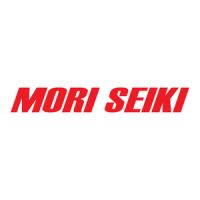2-483MACHINE OPERATIONS OPERACIONES DE MECANIZADO
24-1-2-1 Operation
Operación
1) The B-axis starts positioning at the specified
feedrate under torque limited conditions to the
target position obtained by deducting "K + Q
+ 0.002 mm*" from the position specified as B
(J or V).
* If the target position is set as "B − (K + Q)",
the B-axis position reached by returning by
"K" from the target position without detecting
pushing (the position finally reached) is
always within the tolerance range and it is
therefore impossible to detect an alarm
status. For this reason, the target position is
set −0.002 mm further from the "B − (K + Q)"
position. The system judges that pushing has
not been detected if the B-axis stops at this
position.
2) When chuck 2 comes into contact with the work-
piece, the B-axis servomotor fails to rotate due to
torque limit and only servo error increases.
When the error reaches the value set for the
parameter, the servomotor stops.
3) If the stop position is within 0.1 mm from the
B-axis movement start point or at the B-axis
movement end point, a pushing detection alarm
is triggered.
4) B-axis returns the distance specified by K.
This return travel usually eliminates mechanical
workpiece deflection that might be generated by
pushing operation.
If no K command is specified, the B-axis returns
by "present servo error + 0.1 mm" and then
moves back 0.1 mm in the pushing direction.
5) The torque limited state is cleared.
6) If the returned position is within the allowable
tolerance, chuck 2 is clamped and the program
advances to the next block.
7) If the returned position is outside the allowable
tolerance, steps 1) to 6) are repeated once. If
the retuned position is still outside the allowable
tolerance, an alarm is triggered.
1) El eje B inicia el posicionamiento a la velocidad de
avance especificada en condiciones de par limitado
hasta llegar al punto de destino, que se obtiene
deduciendo "K + Q + 0,002 mm*" de la posición
identificada como B (J o V).
* Si el punto de destino se configura como "B −
(K + Q)", la posición del eje B alcanzada
retrocediendo una distancia "K" desde el punto de
destino sin detectar el empuje, (la posición
finalmente alcanzada) está siempre dentro del
intervalo autorizado y, por tanto, resulta imposible
detectar un estado de alarma. Por esta misma
razón, la posición destino se ajusta −0,002 mm más
allá de la posición "B − (K + Q)". El sistema
considera que no se ha detectado el empuje si el eje
B se detiene en esta posición.
2) Cuando el plato 2 entra en contacto con la pieza, el
servomotor del eje B no gira debido a la limitación de par
y sólo aumenta el error del servo. Cuando el error
alcanza el valor definido para este parámetro, el
servomotor se detiene.
3) Si la posición de parada se encuentra a 0,1 mm del
punto de inicio del movimiento del eje B o se encuentra
en el punto final del movimiento del eje B, se activará
una alarma de detección de empuje.
4) El eje B retrocede la distancia especificada por K.
Esta cantidad de desplazamiento suele eliminar la
deflección mecánica de piezas que podría generarse
mediante la operación de empuje.
Si no se especifica ningún comando K, el eje B
retrocede una distancia equivalente al "error actual de
servo + 0,1 mm" y, a continuación retrocede 0,1 mm en
la dirección de empuje.
5) Se anula el estado de par limitado.
6) Si la posición de retorno está dentro de la tolerancia
admisible, se sujeta el plato 2 y el programa avanza al
siguiente bloque.
7) Si la posición de retorno se encuentra fuera de la
tolerancia permitida, se repiten una vez los pasos
1) a 6). Si la posición de retorno sigue estando fuera
de la tolerancia permitida, se activa una alarma.

